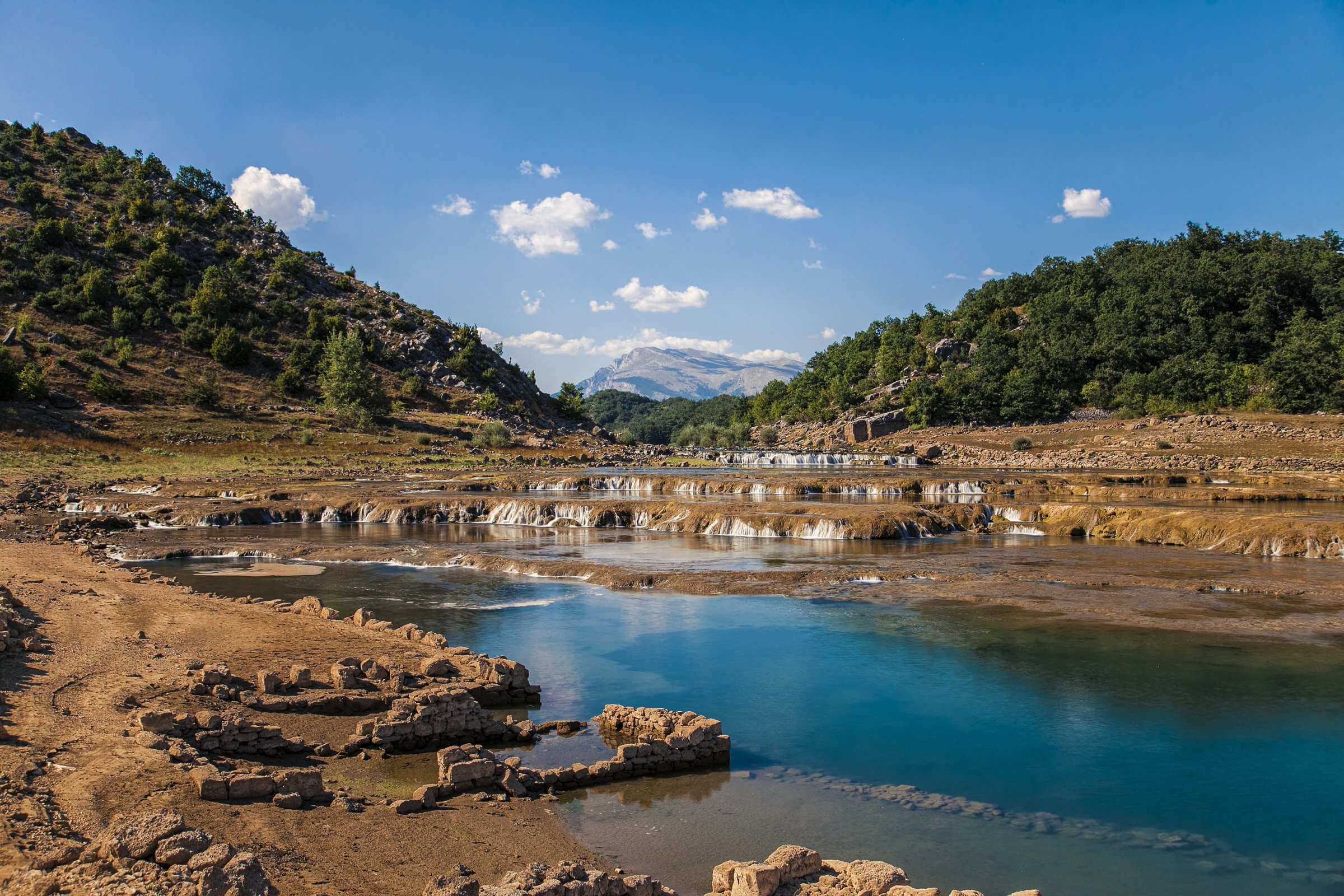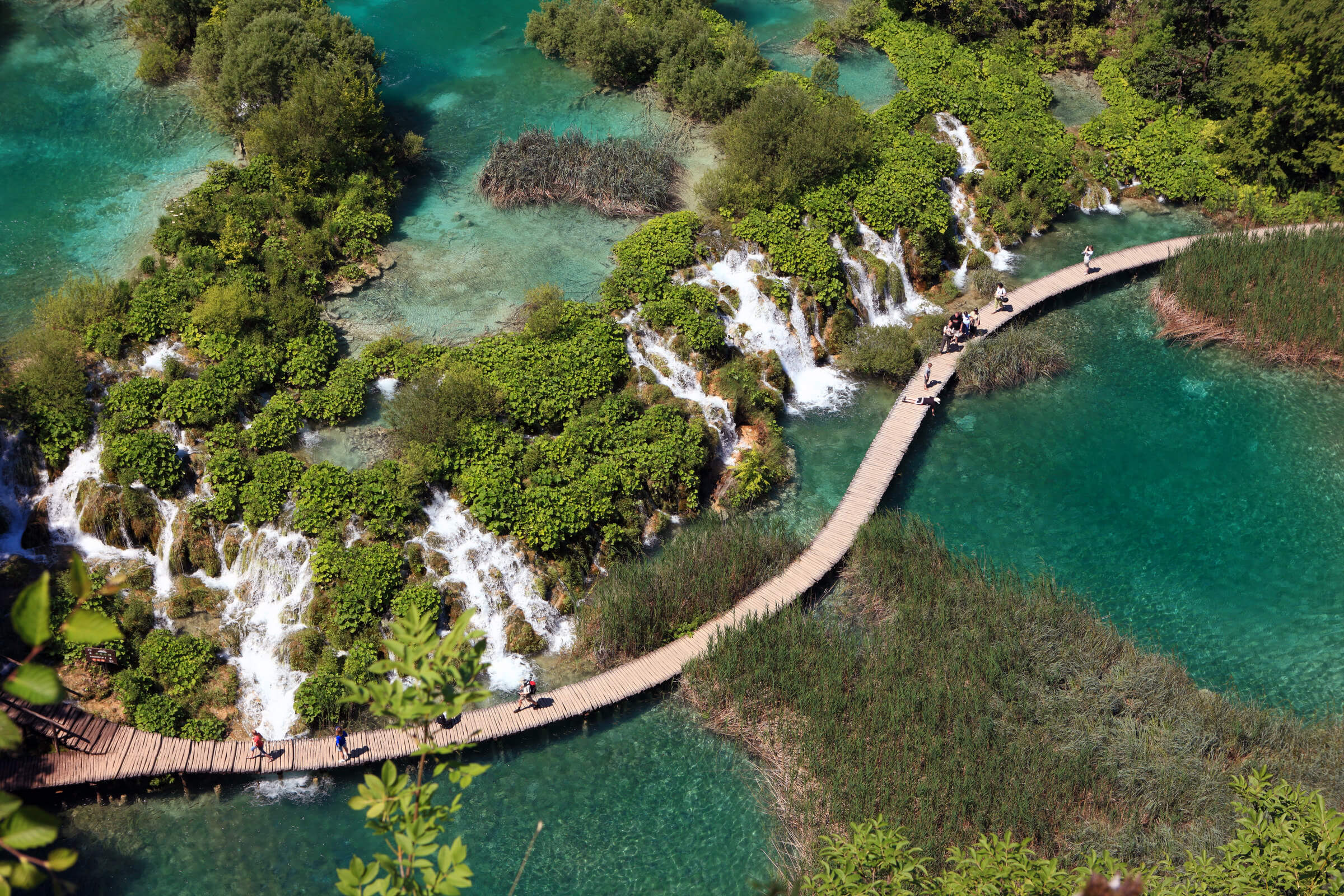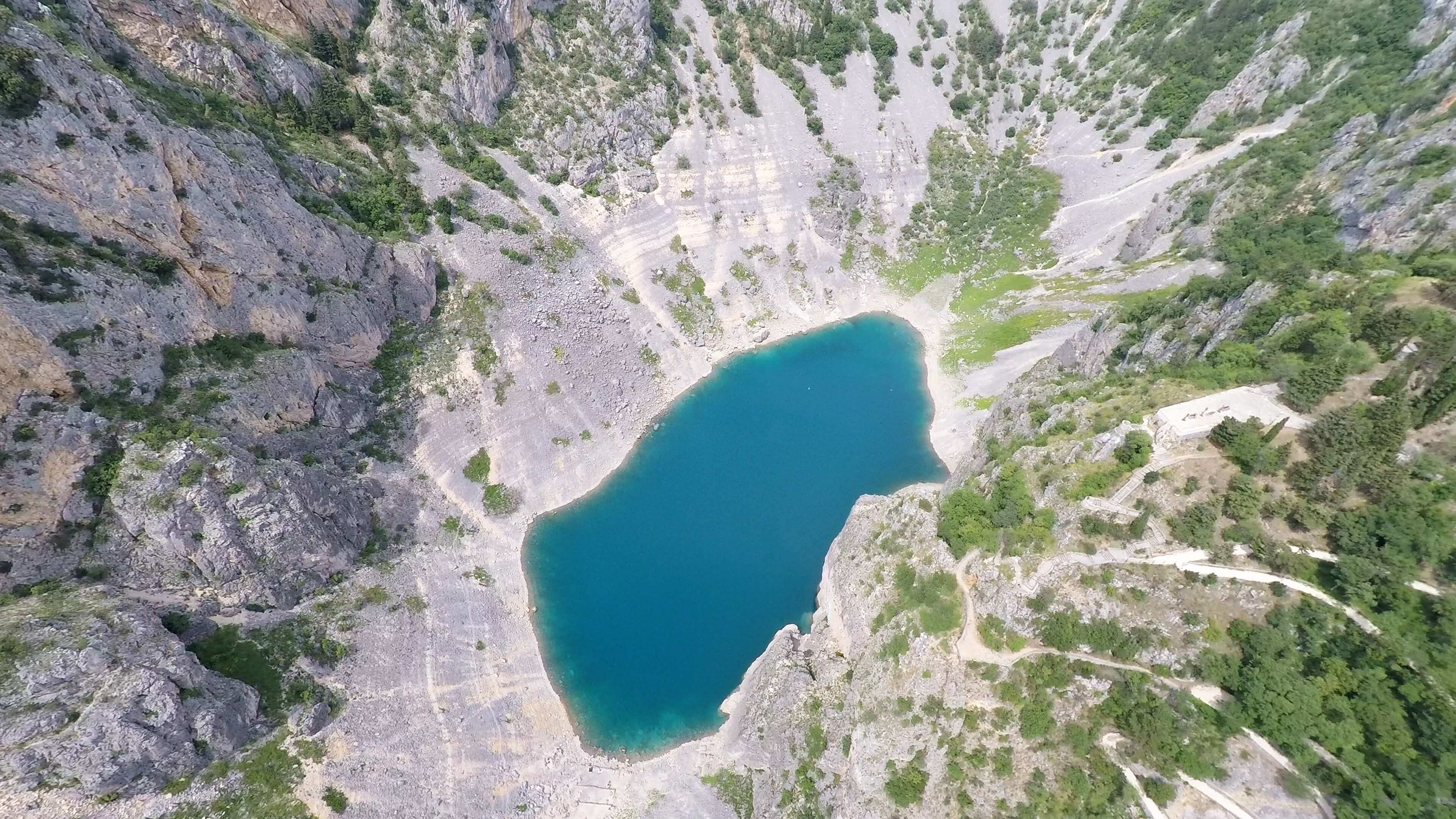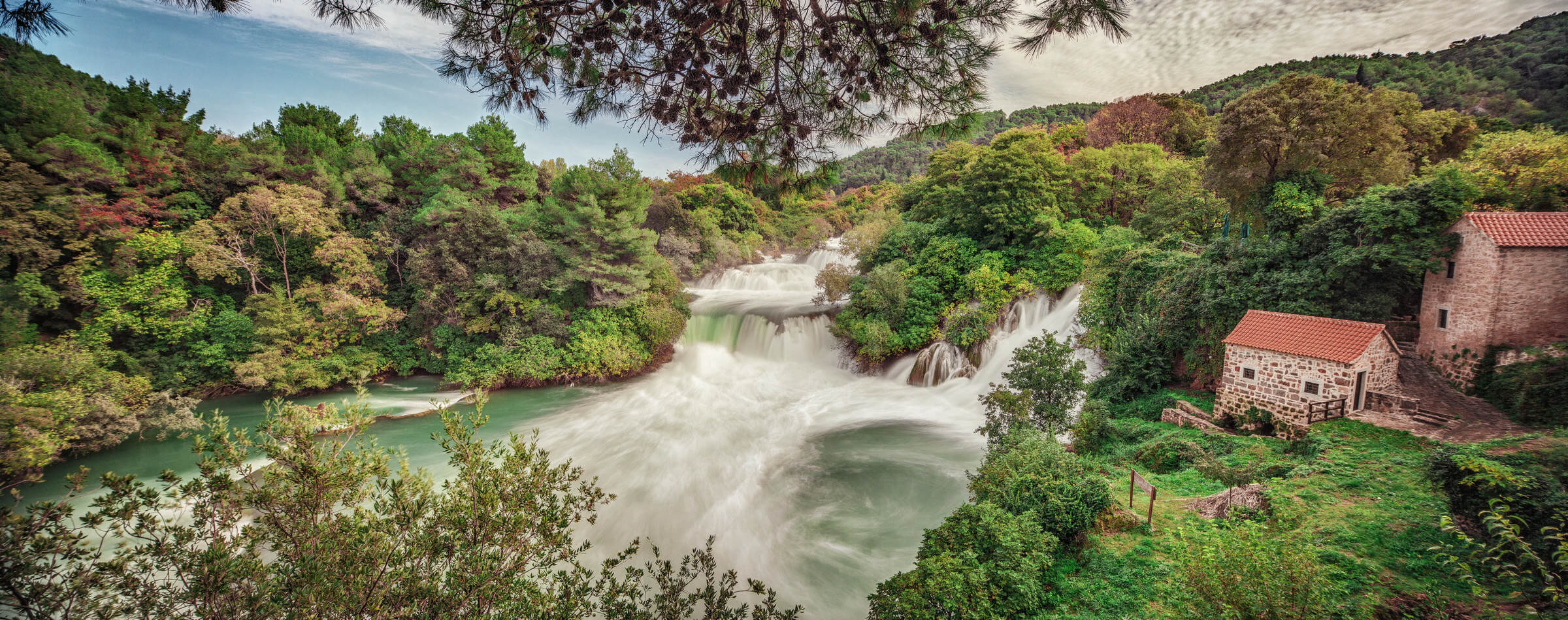Interesting Legends Behind 4 Popular Tourist Destinations in Croatia
July 28, 2021 - Croatia is mostly visited by tourists because of its long Adriatic coast but it's also blessed with enchanting rivers, lakes, and waterfalls. Not many visitors know that the surreal crystal clear blue and emerald colors of Croatia's different bodies of water are also home to many mysterious mythical creatures, historical heroines, and legendary tales. Get to know the mythical inhabitants of Croatia and explore the world of epic Croatian folklores in 4 popular tourist destinations in Croatia.
Cetina and the Story of Mila
 Photo credit: Mario Romulić
Photo credit: Mario Romulić
Gushing under two mountains, the Dinara and Gnjat, and passing through the scenic towns of Sinj, Trilj, Zadvarje, and Omiš where it finally meets the Adriatic Sea, the Cetina River is one of the most beautiful canyons in Croatia and is a famous day trip destination for both locals and tourists. Considered the longest river in Dalmatia with its length of 101km, Cetina is a perfect place for canyoning, zip-lining, freshwater kayaking, and white water rafting. The clear blue water of the Cetina River has been a generous source of clean water and freshwater fish for the people of Dalmatia over the centuries. Thanks to the nymph named Cetina, this beautiful river came to life. According to legend, Cetina desperately dreamed of conceiving a child and was tricked by the sexually ravenous God, Zeus, who promised to bore her an offspring after their union. After many weeks of waiting, Cetina did not get pregnant and upon realizing Zeus' trickery, the heartbroken nymph wept endlessly until her tears formed a river and eventually, the Cetina dried up and turned into stone. The Neolithic people believed that a person who wishes to conceive will be blessed with a baby of good fortune after bathing in the tears of the late demigoddess. There is also another story in Cetina that is historically significant to Croatian people. It is the story of a brave and clever woman who single-handedly defeated a whole Ottoman army - Mila Gojsalić.
In 1530, Ahmed Pasha led a powerful Ottoman army to conquer the Republic of Poljica, now known as the modern-day Omiš. The army terrorised, pillaged, and ravaged the people of this place for a long time, but just before their final attack and Poljica's fall, a young beautiful woman named Mila Gojsalić appeared before the army. According to stories, Mila was very beautiful and her charm easily bewitched Ahmed Pasha who fell right under her spell. Mila pretended to be in love with the leader of the Ottoman army and she ended up sleeping in the leader's tent. That evening, Mila sacrificed her chastity and life for her people. After making sure that Ahmed and his men were asleep, she snuck into the gunpowder storage with a torch and blew up the whole military camp. The powerful blast killed Ahmed Pasha and most of the Ottoman warriors, including the beloved heroine of Poljica. Although some stories claimed that Mila escaped the camp and plunged from the high cliffs down to her death in the river of Cetina.
 Photo credit: By Ivan T. - Own work, CC BY-SA 3.0, https://commons.wikimedia.org/w/index.php?curid=17699310
Photo credit: By Ivan T. - Own work, CC BY-SA 3.0, https://commons.wikimedia.org/w/index.php?curid=17699310
The heroic act of Mila ignited courage from the people of Poljica who began to fought back until every single one of the Ottoman invaders was dead. To honor Mila's sacrifice and bravery, the greatest Croatian sculptor Ivan Meštrović created a statue of her. In the village of Gata, overlooking Cetina and Omiš stands the statue of Mila Gojsalić - a heroine who watches over the people of Omiš day in and day out.
Plitvice Lakes and The Black Queen
 Photo credit: Mario Romulić
Photo credit: Mario Romulić
The Plitvice Lakes National Park is probably the most famous national park in Croatia. Millions of tourists flock to visit this magnificent landscape that is consisted of 16 crystal shades of blue and emerald lakes which are connected by many rivers, streams, caves, and waterfalls and are surrounded by luscious green woodland. This incredible scenery was created by the endless stream of waters that have been flowing over limestones and chalks for thousands of years, until eventually forming natural dams through deposits of travertine barriers. All thanks to nature's wonderful phenomenon, a series of 16 beautiful lakes came to life!
But Croatian folklore, on the other hand, believes that Plitvice Lakes appear magical because it was, indeed, magical. Legend has it that a long time ago, the area of Plitvice only had one source of water - the Black River (Crna Rijeka). Unfortunately, the area was struck with a long-lasting horrible drought which dried out the Black River, and the crops, livestock, and people began dying. In despair, the people prayed and cried all day to the heavens for some rain, but for a very long time, their prayers were left unanswered. They were close to giving up when the Black Queen, who had just left her fairy palace to head to an area near Plitvice, happened to hear their pleas. After witnessing the damage of the drought to the people, the Black Queen said, “I am sad to see that you are suffering!” After that, the winds and thunder started to roar and strong rain came and poured for days and days on end until the Black River overflowed and 13 lakes appeared. People believed that the Black Queen cried for the people's misfortunes and her black and white tears formed the Black River and the White River in Plitvice. Together with the Matica River, they form the first lake and it was named Prošćansko (prošnja = prayer), to commemorate the prayers of the anguished people. For their token of gratitude to the Black Queen, the people of Plitvice built her a castle on the hill above lake Kozjak, where she can admire the splendour of her own creation.
Imotski's Red and Blue Lakes and The Wicked Gavan Family
 Photo credit: By Yacht Rent from Croatia - modro jezero Croatia, CC BY 2.0, https://commons.wikimedia.org/w/index.php?curid=81974343
Photo credit: By Yacht Rent from Croatia - modro jezero Croatia, CC BY 2.0, https://commons.wikimedia.org/w/index.php?curid=81974343
A small town that is perfect for travellers who wish to steer away from the frenzy of tourists, Imotski is Dalmatia’s hidden gem packed with nature, culture, history, and friendly locals. Unlike the busy coastal cities of Dubrovnik and Split, Imotski possesses a different charm - tucked in the inland region of Dalmatia without the Adriatic Sea, this town, instead, offers an array of unique and breath-taking landscapes to its visitors. Imotski is rigged with incredible karst formations such as hidden caves, sinkholes, karst rivers, lakes, and canyons. The distinctive geographical formations of Imotski inspired countless folk tales including fairies, heroines, and goblins. Perhaps the most famous of these intriguing formations are the Red and Blue Lakes, two magnificent karst lake formations which, according to Croatian folklore, have emerged to swallow the palace and wealth of the wicked Gavan family.
Named after the reddish color of the surrounding cliffs, the Red Lake is a beautiful karst lake and the third largest sinkhole in the world. It can't be reached on foot and without special equipment. Meanwhile, the Blue Lake is easily accessible and is located just beneath the historical Topana Fortress in Imotski. Locals and tourists are welcome to swim in the calm, turquoise blue water of the lake. The stunning and serene blue lake, however, hides a story of the evil Gavan family who used to live in the area of Imotski. According to folklore, Gavan with his wife, Gavanica, and their children, were the wealthiest and most powerful family in Imotski. Nonetheless, the Gavan family was known to be very cruel and vile towards their servants and neighbours and the only thing that mattered to them was their wealth. An angel heard about Gavan’s horrific acts and decided to descend down from heaven to test the Gavan family. The angel disguised as a beggar and knocked on the Gavan's palace door to ask for help. Gavanica opened the door and refused to provide any help to the beggar. The angel then asked Gavanica, “Are you not afraid of God’s punishment?” The arrogant woman replied, “What good can God do for me when I have my Gavan?” It was then that the angel revealed his disguise and punished the Gavan family. It was believed that the ground where the Gavan’s palace stood cracked open and swallowed the Gavans and their entire wealth. The locals still believe that the deep hole, now covered by the Red and Blue Lakes, still contain the palace and wealth of the family and on windy days when the bora wind blows, the screams of Gavan and Gavanica can still be heard around the area of these lakes. The locals also claim that beautiful fairies who live in the Fairy Cave in the Blue Lake have been sighted basking in the beauty of the lake at sunset and dawn. There is a current rumor that no human has ever managed to set foot on the Fairy Cave.
Stories of fairies and foes aside, the Blue Lake transforms into a spectacular football field every few years when it dries up. Many people flock to Imotski to witness these rare and out-of-this-world football matches on Imotski’s mysterious lakebed.
Krka National Park and The Tragic Love Story of Bogdan and Miljeva
 Photo credit: Mario Romulić
Photo credit: Mario Romulić
One of the most visited national parks in Croatia, Krka National Park has it all - the iconic Skradinski Buk waterfall, Neolithic cave, Roman architecture remains, Krka Monastery and so much more! It is also very accessible especially if you are coming from the coastal cities of Split and Šibenik. The park which is filled with dazzling waterfalls, gorges, and the 73km-long Krka river that gushes through a karstic canyon of 200m deep are intertwined by walking paths, hiking trails, and wooden bridges. The park has five main entrances: Skradin, Lozovac, Roški Slap, Krka Monastery, and Burnum, and all are accessible by car. But before becoming Dalmatia’s most famous tourist attraction, Krka National Park is built from the tragic love story of Bogdan and Miljeva.
A long time ago, the mighty Prince Bogoje lived in the area of Krka. In Bogočin, he built a beautiful palace for his son, Bogdan, who was set to marry a lovely noblewoman who lives in the town of Ključ across the river Čikola. That woman’s name was Miljeva and she was the daughter of influential Ban Domagoj and his wife Čika. Bogdan and Miljeva were cherished by the townspeople and on their wedding day, a large gathering of seven bans and twelve county prefects have gathered in Bogočin to witness the union of the beloved couple. The wedding was a success and everyone headed to the palace to celebrate the newlyweds where a tragic fate awaited the couple. During the celebration, a terrifying dragon descended into the party and dragged Princess Miljeva to the bottom of Lake Brljan. Prince Bogdan came to rescue his bride but the beast drew him to the river of Krka as well. This tragedy broke the heart of Prince Bogoje who used up all his wealth to grieve the loss of his son and Miljeva. With his riches, he built Aranđelovac monastery, a place to pray for the souls of the lovers. He also built the towns of Čučevo and Nečven to symbolize the love between Bogdan and Miljeva. In addition, he built two bridges which connect Roški waterfall and river Miljacka. Local folks believed that anyone who wishes to cross the bridges has to shed two tears to pay homage to the tragic fate of Bogdan and Miljeva's love. In the end, Prince Bogoje tore down the Bogočin palace and set off from this grief-stricken town into the unknown. Meanwhile, Miljeva’s mother, Čika, secluded herself to pray for the late lovers in a tower she built in Ključ.
Because of this tragic love story, Bogočin is known by the locals as a “fairy town”, the river near Ključ is named Čikola and the area between Bogočin and Ključ is called Miljevci.
For more on Croatia's top travel destinations, follow Total Croatia.
For more on travel, follow TCN's dedicated page.
For more about Croatia, CLICK HERE.
From Bare to Brimming: Blue Lake Transformation Video
February 20, 2021 - EdoStuff Aviation films the Blue Lake transformation, from bare to brimming.
Dalmacija Danas writes that the Blue Lake is one of the most beautiful Croatian lakes, reachable by a staircase, making it a favorite beach in the summer months. It often dries out, and football is traditionally played at its bottom.
Another natural charm of the area is the Red Lake, named after the red rocks at the edge of the lake. This karst pit is about 528 meters high, and the depth of the lake is about 281 meters, which, according to some data, could be the deepest lake in Europe. The Red Lake cannot be accessed due to the steep cliffs that surround it.
Imotski is known for these two natural pearls. However, an increasingly popular destination for adventurers and guests is Lake Ričice, better known as the Green Lake.
The lake is located near the village of Ričice in the northwest of Imotski Krajina. The lake is fed by the Vrbica and Ričina rivers. It was created in 1985 when a dam was built to prevent water penetration, and the water from the reservoir was to be used for irrigation. However, the project was never completed so a lake was created at this location.
In the last few months, the Imotski area, as well as the entire region, has gone through hydrologically extremely different periods. By November, we experienced an extreme drought, and the Blue Lake dried up as much as twice in late summer and fall. It has been raining since November, and the peak of rain was in December and January when precipitation records were broken locally.
Not only are the dry riverbeds full, the groundwater is at maximum capacity, and the level of the Imotski lakes is also extremely high.
Both situations were recorded by YouTuber EdoStuff Aviation, which compared the appearance of Imotski lakes during the peak of the drought to today. Incredible scenes!
To read more about lifestyle in Croatia, follow TCN's dedicated page.
Geological Park Biokovo Imotski Lakes In UNESCO Network In Two Years
December 9, 2020 – After Papuk Nature Park and Vis Archipelago, Croatia will soon get another geopark under UNESCO protection. If everything goes according to plan, Geological Park Biokovo Imotski Lakes' proclamation is expected in the next two years.
As Lokalni.hr reports, the National Commission for UNESCO Geoparks of the Republic of Croatia sent the UNESCO Council of World Geoparks based in Paris documentation for registration and accession of the Biokovo-Imotski Lakes Geopark area to the network of UNESCO World Geoparks.
A unique area of Dinaric karst
"This completes a significant chapter on our path to the ultimate goal of becoming a Geopark under UNESCO protection," said Luka Kolovrat, director of the Imotski Tourist Board Imota.
The arrival of UNESCO evaluators is expected in the summer, and if everything goes according to plan, the Biokovo-Imotski Lakes Geopark's proclamation will be in the next two years.
"The initiative was launched in 2018 when we reported the Imotski Lakes Geopark project to the National Commission, and at the same time, the Biokovo Nature Park had a similar initiative. The position of the Commission was to unite the initiatives and to approach this project together," says Kolovrat.
There are many reasons for this. One of them is that the area of Imotski Krajina (Imotski region) with the Biokovo Nature Park is a geologically, geomorphologically, and unique landscape area of the Dinaric karst. Thus a joint application would use the potential of both areas for the benefit of the local community.
"At the end of 2018 and in 2019, the City of Imotski carried out a very complex and comprehensive geological research of the area of Imotski Krajina. It was the basis for future applications. The Geological Institute prepared the geological brochure of Imotski Krajina. At the same time, we conducted intensive negotiations with representatives of PP Biokovo on a joint application, defining names, headquarters, borders, coverage, management of Geopark, etc. At the end of 2019, the geological brochure was presented to the public, and the association Geopark Imotski Lakes was founded, which took over the management, operational affairs, and coordination from the Imotski Tourist Board," Kolovrat states the chronology.
In May this year, they sent a letter of intent to the Ministry of Economy and Sustainable Development. In July, they presented the project, after which they received a letter of support from them.
A piece of the planet of inestimable wealth
The next step is the arrival of UNESCO evaluators in the summer, and until then, they have a lot of work to do.
"In the next period, we need to implement the activities from the management plan: mark about a hundred sites that we have identified as geological, natural, and cultural sites, mark geological trails, do training for agencies, renters, family farms who should become partners of Geopark, create a bilingual website, promotional video, print brochures and various promotional materials," announces Kolovrat.
UNESCO Geoparks are unique geographical areas of international importance governed by a holistic concept of protection, education, and sustainable development.
"The UNESCO brand will lead to the recognition of our area at the global level. The creation of innovative crafts and new jobs encourages new sources of income as part of geotourism, strengthening the local community. At the same time, the geological, natural, and cultural heritage of the area remains protected. We believe that this piece of a planet of inestimable wealth on which we have the privilege to live, and we are its heirs, deserves to become part of the UNESCO family to the pride of us and the generations to come," says Kolovrat.
Geological treasury of Croatia
Due to its geological diversity and numerous fossil finds of organisms from the Pannonian Sea, the Papuk Nature Park was the first Croatian Geopark under UNESCO protection. Papuk is also in a nature park category since 1999, and the first geological natural monument in the Republic of Croatia is located in the Park.
Last year, UNESCO added three European sites to its geological parks, including the Vis Archipelago. In the geological past 220 million years ago, a magmatic breach formed the present islands of Jabuka, Brusnik, Biševo, and Palagruža. Palagruža is also geologically the oldest island in the Adriatic, which, like the island of Brusnik, is continuously growing under the influence of tectonic activity.
For the latest travel info, bookmark our main travel info article, which is updated daily.
Read the Croatian Travel Update in your language - now available in 24 languages
Geopark 'Biokovo and Imotski Lakes' Launch Joint Initiative to Become UNESCO Geopark
June 4, 2020 - Geopark Biokovo and Imotski Lakes has launched an initiative to join the UNESCO Global Geopark network.
HRTurizam reports that UNESCO Geoparks are unique geographical areas of international geological significance governed by a holistic concept of protection, education, and sustainable development.
Precisely with the aim of protection, sustainable development and tourism, the Association Geopark Imotski Lakes and the Public Institution Nature Park Biokovo launched an initiative to establish "Geopark Biokovo-Imotski Lakes" to join UNESCO Global Geoparks.
One of the main ways to stimulate the economy and sustainable development of the future UNESCO Geopark is through geotourism, says Luka Kolovrat, president of Geopark Imotski Lakes, adding that by raising awareness and educating about the importance of geological heritage, UNESCO geoparks give the local community a sense of pride and strengthen their identification in the area they live.
“Geoparks attract a larger number of visitors with their activities and enable the launch of various production and service activities that contribute to the socio-economic development of the community. Not only geologically interesting places, but also various other ecological, archeological, historical and cultural sights contribute to geoparks, and they are supported and actively participated by local communities that know how to recognize and want to affirm their geological, historical and cultural heritage, mostly through the idea of geotourism. The opening of innovative crafts and new jobs encourages the creation of new sources of income within geotourism, strengthens the local community, and at the same time, the geological resources of the area remain protected," says Kolovrat.
The boundaries of the future Geopark Biokovo-Imotski Lakes have already been determined, and their total area is 431 km2. They cover the areas of the municipalities of Imotski, Proložac, Podbablje, Zmijavce, Lokvičići, Lovreć, Zagvozd and Runovići.
"Our joint initiative stemmed from the fact that the Biokovo Nature Park and the Imotski region form a geologically, geomorphologically and landscape-unique area of the Dinaric karst, and our wish is to use the potentials of both areas for the benefit of the local community," Kolovrat points out.
In general, when we talk about the area that will include the future Geopark Biokovo-Imotski Lakes, it is an area that in addition to attracting attention with its relief and geomorphological forms, or numerous karst phenomena, adorns a great wealth of flora and fauna including many endemic species.
In addition to the most attractive protected natural monuments and phenomena of world importance, the Red and Blue Lakes, there is also the Krčevac spring, which is currently the only confirmed locality of Proteus anguinus in the Imotski region. There is also the Zovnjača cave in the municipality of Podbablje, which was recently established as an important archaeological and biospeleological site.
Other sights include the Opačac spring, the Vrljika river, Ričice lakes, Galipovac, Knezovića and Mamića lakes, Prološko blato, Lokvičićka lakes, Dva oka and numerous other localities that were created during a long geological period by the tireless work of water. The ichthyofauna of the Imotski region is significant for several protected endemic species, and some of them are soft-mouthed trout (Salmothymus obtusirostris), Croatian roach (Rutilus basak), Imotski gaovica (Delminichthys adspersus), Squalius microlepis, and Cobitis.
So far, numerous systematic and complex geological surveys have been carried out, monitoring is being carried out, the public is being educated, brochures, guides, manuals, and educational materials have been printed.
The joint Geopark website is being developed, as well as the creation and marking geo-trails, and a joint Facebook page has been created, which is updated daily, points out Ivana Ćapin from the Association Geopark Imotski Lakes and adds: “Since we are aware of the great potential of the area which we live with all its features, together we embarked on this challenging project to become part of the international network of UNESCO Geoparks. As for our future joint activities, they are holding a presentation in November this year, then making a ten-year study with a management plan, and marking the geo-trail of the future Biokovo-Imotski Lakes Geopark. And most importantly, in the summer of 2021, the arrival of the Commission and evaluation is expected, and after that the accession to the network of world Geoparks under UNESCO protection," emphasizes Ćapin.
The network of UNESCO World Geoparks consists of areas of the geological and geomorphological heritage of international importance, while the goal of the UNESCO World Geoparks program is to protect geological, geomorphological and other values of geoparks and manage the area through education and implementation of activities following sustainable development goals and for the benefit of the local community.
We currently have two UNESCO Geoparks in Croatia: the Papuk Nature Park and the Vis Archipelago, and we will soon find out whether the Biokovo-Imotski Lakes Geopark will become the third UNESCO Geopark in Croatia.
More information can be found HERE
To read more about lifestyle in Croatia, follow TCN's dedicated page.


